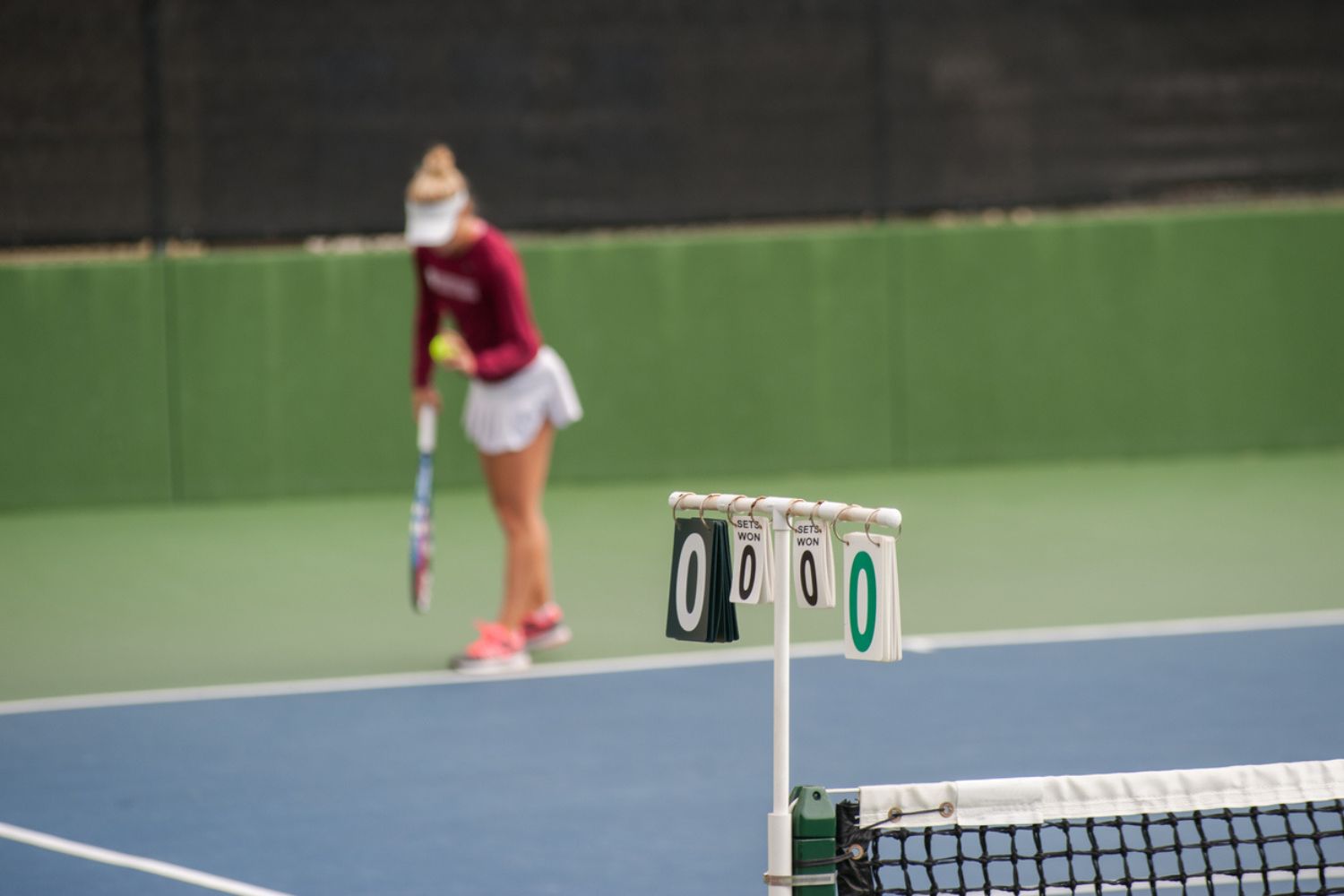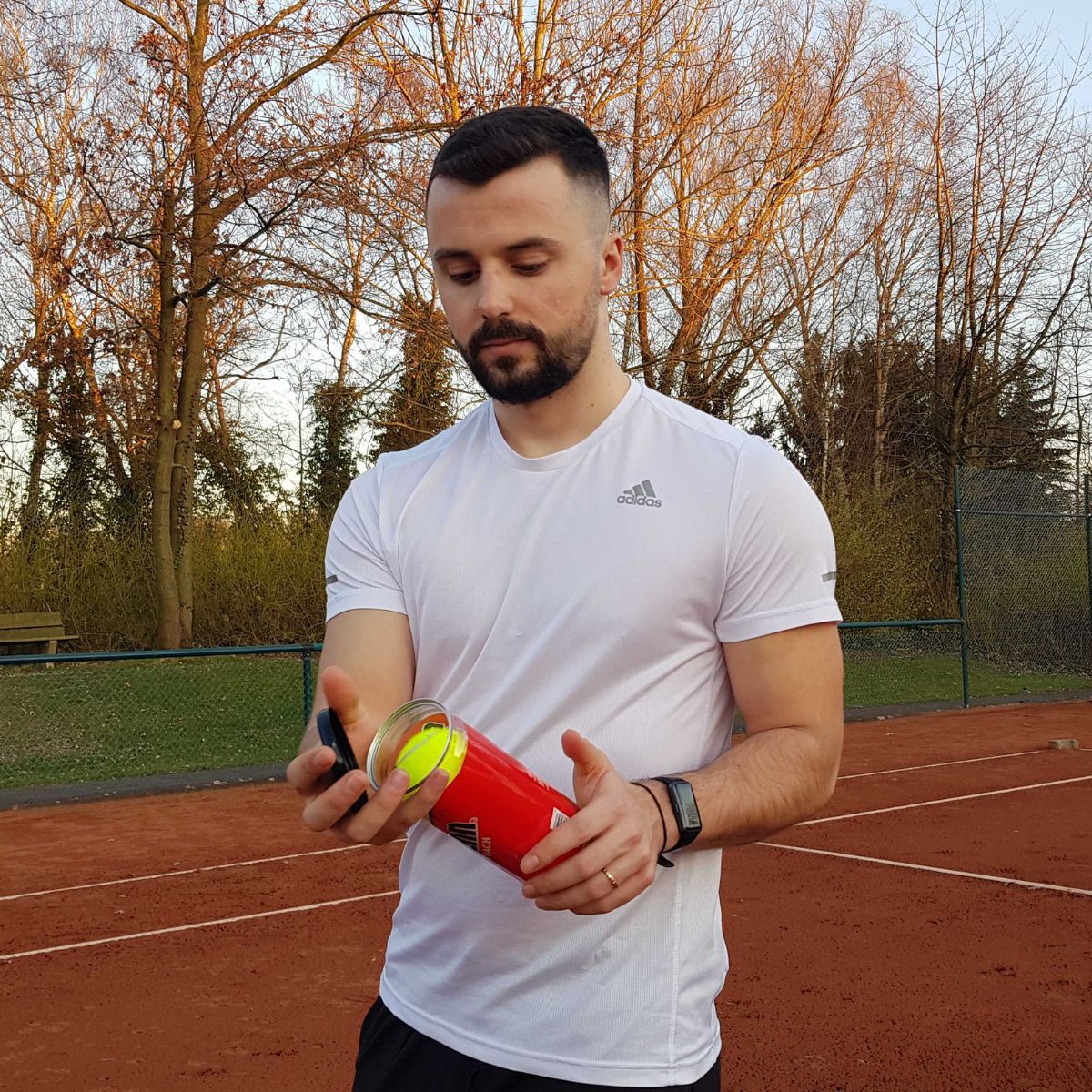Tennis is one of the world’s most popular games, with millions of players and an ever-growing interest in this sport. If you are a newbie on the court, you surely have an exciting journey ahead, but to get there, it’s important to learn all about the tennis rules. It might seem complicated at first, so you can start by memorizing the general rules and then move on to other details regarding different shots and the scoring systems.
In this guide, we got you all covered up by walking you throw easy-to-follow explanations. With our handbook and a little patience, you can learn all rules of tennis in no time, which will boost your confidence, and build your first skillset in tennis, even as a beginner. Let’s dive in!
Basic Rules of Tennis
- In a single game, two players compete against each other, while in double games, there are teams of two players playing.
- The player should position themselves on opposite sides to hit the ball with a racket.
- For the game to continue, the ball must always be within the bounds layers, otherwise is a lost point.
- It’s forbidden to touch the balls more than once during a shot.
- It’s forbidden to touch the net or to cross to the opponent’s side of the court.
- The points always start by performing a serve while the opponent attempts to return the serve.
- If the return of the server fails, then the point goes to the player that served.
- In case a player loses the racket during the game, it counts as a penalty.
- In case of verbal abuse from one of the players, it counts as a penalty.
- The ball should not touch or directly hit the player; otherwise, it counts as a penalty.
- If the ball touches the borderline, it is IN because they are also part of the court.
Tennis Serve Rules
The very first rule you should memorize is that the match always starts with a serve. To decide which of the players or the teams has the first serves, it’s common to flip a coin; this is known as a toss. The player that called it correctly can go first, but the other one can choose the preferred side of the court to play.
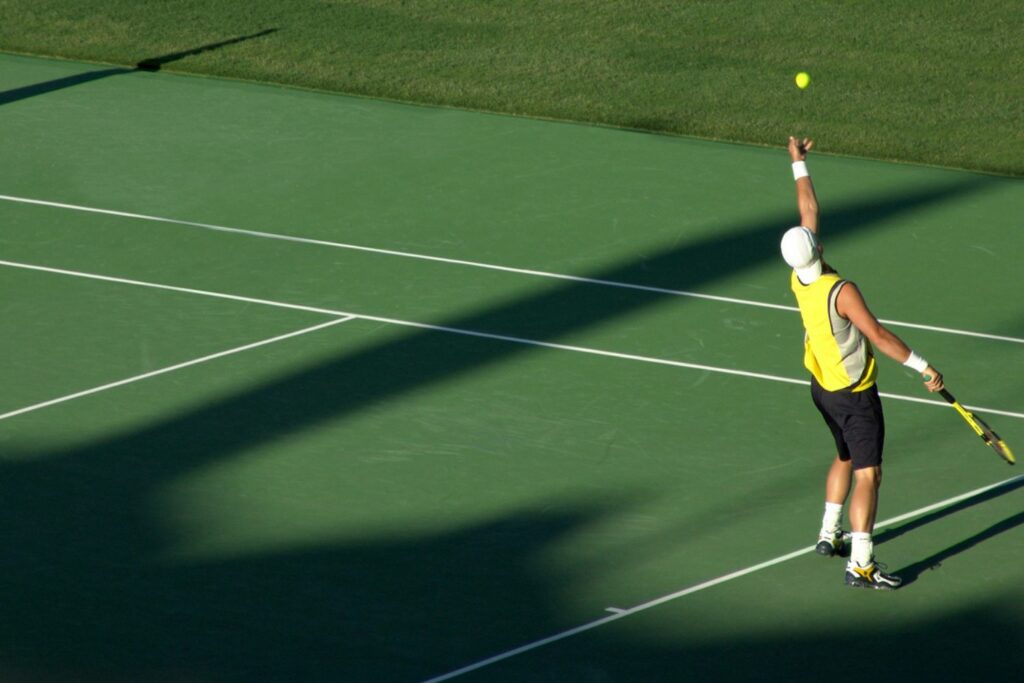
The server should always position themselves in between the sideline and the center mark, behind the baseline, diagonally to the service box. Single players should refer to single sidelines, while teams should refer to double sidelines.
After the first serve, the opponent should return the ball; otherwise, it’s a point lost. The server must always aim to hit the ball within the other player’s service box, or else it is considered to be a fault. However, it can shoot a second serve to start the match. In case the serve again misses the service box, it’s a double fault, and the point goes for the opponent.
After a successful serve and return, the players exchange shots until one of their losses a point. This is known as a rally, and it’s one of the main basis of tennis. If you are serious about the game, it’s important to practice more of it until you are able to rally constantly, with ease.
Here are the most important technical tennis serve rules that you should know;
- Proper serve – if the player lands the serve correctly, within the opponent’s service box, and the ball is in the game, in a constant exchange of shots.
- Foot fault – it is when the server steps forwards on the court from the position that is standing, passing the center mark without having contact with the ball. In this case, the server is a loss, and the point goes to the opponent.
- Let – when the ball doesn’t land in the correct service box because it hits the net cord first. In this case, the server it’s entitled to another service. The Let re-do’s are not limited in number, so a player is technically allowed to hit as much as possible; however, this just doesn’t happen that often.
- First service – the first attempt for the server to land the ball within the opponent’s service box.
- Second service – the second attempt for the server to land the ball within the opponent’s service box. If it fails again, the point is lost.
- Orders of service – are determined by the player or the team that wins the toss and can serve first.
- Switching sides – the players or the teams switch sides with each other every time the number of the games is “odd,” or in other words, a prime number like 3, 5, 7, and so on.
Tennis Scoring Rules
Playing tennis is exciting and enjoyable but can be confusing, especially when it comes to scoring. Tennis scoring rules are unique and don’t apply to any other sport. It might be challenging at first, but once you get the hang of it, the system is perfectly clear.
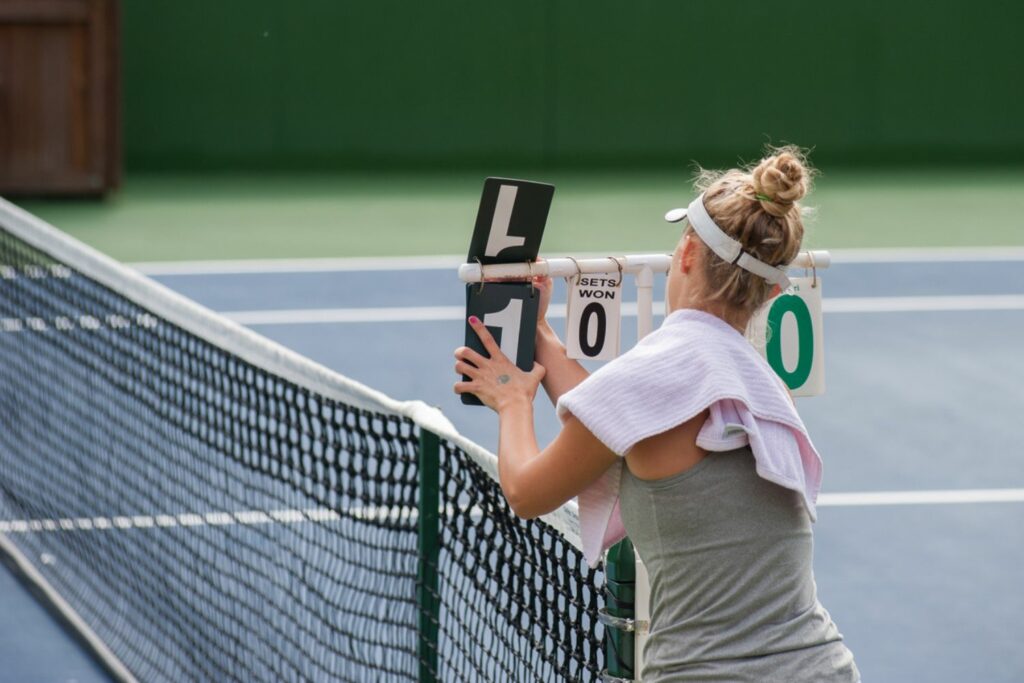
Here is all that you should know about tennis scoring rules;
Match
When two players or teams are competing against each other for whatever tournament they are in, that is referred to as a match. Many beginners make the genuine mistake of calling tennis matches “games,” but ask any person with some experience on the court, and the meaning of the word is completely different due to the scoring system that we’ll explain below.
For comparison’s sake, a soccer or basketball game is equal to a tennis match. With that being said, it’s important to use the right terminology in court.
Points
Each point starts with a serve, and this is the smallest unit of measurement in tennis. According to official tennis rules, there are unique values attached to points.
- 0 points= Love
- 1 point = 15
- 2 points = 30
- 3 points = 40
- 4 points = win (a game)
In case someone has 0 points, we call it the result “love” because it is presumed that the player is still on board for the sake of the love for tennis. Therefore it’s not 15-0, but 15-love, and so on, until the player scores points. In case the result is even for both players, we use the word “all” instead of repeating numbers. For example, 15-All, instead of saying it 15-15.
Games
A game is won if the player scores 4 points and has at least 2 points of advantage compared to the opponent.
Sets
To win a single set, the player should score at least six games and remain at least two games ahead of the opponent. Tennis tie-break rules refer to an extra game, which is given in a scenario where the result is even between the players.
This helps to determine a winner for the set. Another way to do this is by adding an “advantage set,” which allows the players to continue rallying until one of them takes the lead with two more games.
Match
So who wins the match, you might ask? Usually, the winner is determined as “the best of three,” meaning that one of the players has at least two sets. In some rare exceptions, the player should win the “best of five” with a minimum of three sets.
Tennis Doubles Rules
Generally speaking, the tennis rules for single and double players are pretty much the same; however, there are some exceptions.
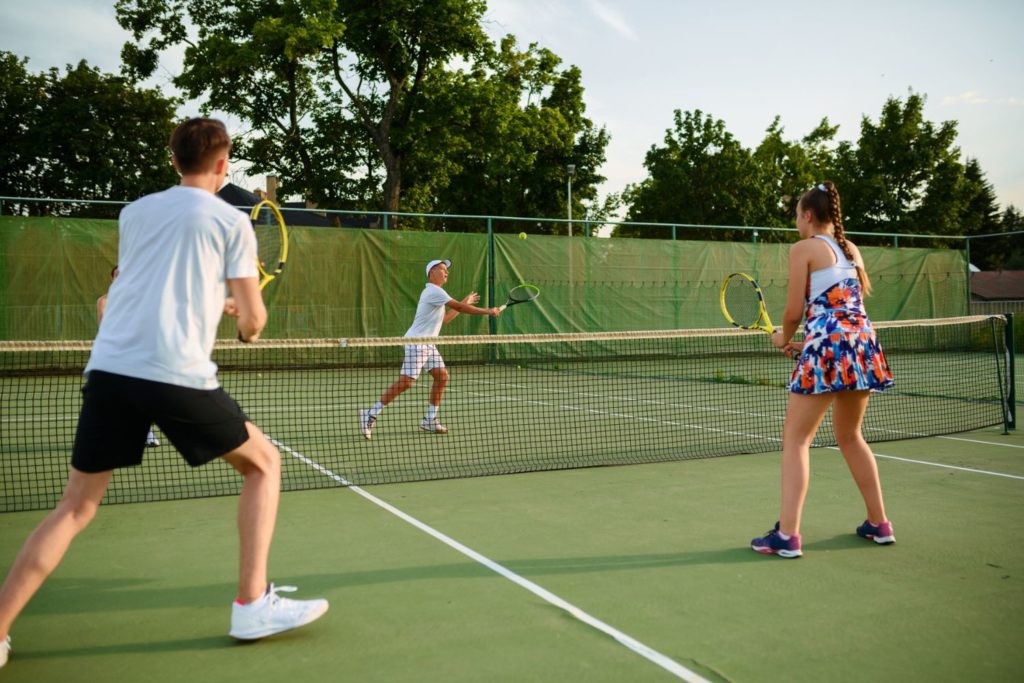
For starters, the court’s area that two players should cover is larger compared to a single one, so they have to put in extra effort as a team. Serving also works a little differently because, on a team, players have to take turns. They can decide who goes first; however, it’s forbidden for the same team player to serve twice in a row.
The team players should also agree on which one will take the right or the left side of the court to perform a service and stick with that until the end of the match. Tennis double rules allow players to stand wherever they want when their partner is serving.
Beginners and lower intermediate usually go up in the front, on the other side, so that they can be in a better defensive position. More advanced players usually stay on the same side as their partners for a better strategy of the game.
Unusual Tennis Rules
Some tennis rules are considered unusual for the simple fact that many people simply aren’t aware of their existence. Learning about them can always be useful because you never know how they can come in handy, so you don’t risk some precious points during a match.
- Don’t make any noise – a player can grunt, but making other noises that distract the opponent is forbidden and will mean the point is lost.
- Don’t touch the ball – you can only use the tennis racket to touch and hit the ball. The direct contact of the ball with any part of the body will cost the player a point, even if that happens unintentionally.
- Stay away from the net – even if it happens by accident, if the player physically touches the net while the point is still in play, it immediately loses a point.
- Hit the ball around the net – if you are skilled enough to hit the ball around the net and still manage to land it on the opponent’s side of the court, then do it. It is completely allowed, and you will certainly impress many people with this difficult shot.
- Keep your racket always close to you – when hitting a shot, the racket should always be in direct contact with the player’s body. If, during an out-of-rich shot, the player manages to hit the ball so it can land on the other side of the net, but in the process, the racket slips from his hand, then the point is lost.
- No ‘ad’ rule – in some occasions, this rule is applied to keep the match at a fast rate, and the result comes out faster. Basically, these rules mean that when the score is even, the player who wins the next point has won the match.
Violations of Tennis Rules
Tennis rules and regulations are very strict when it comes to violations. Depending on the severity of the violations, the penalty can vary from the loss of points, the loss of a match, fines, and sometimes even suspension from tournaments.
Here are some of the most frequent violations that you should avoid at all costs;
- Physical abuse – any form of behavior that is considered abusive or/and aggressive can be considered physical abuse. Hitting the ball outside of the point, for example, might not seem as much, but it is not tolerated. If the player gets violent with the opponent, a member of the staff, or a fan, the consequences can be severe, depending on the scale of the aggression.
- Verbal abuse – any form of bullying, degrading or mocking, name-calling, intimidation, etc., towards the other player, staff, or fans is considered verbal abuse.
- Tennis equipment abuse – hitting or destroying tennis balls, rackets, or other gear is a violation of the rules.
- Obscenity behavior – any kind of gesture or word that is considered obscene and offensive is a violation of the tennis rules.
- Coaching – instructions out of the ongoing game are not allowed.
- Best efforts – if one of the players is intentionally not performing to the best of their abilities to purposefully lose the game, it is considered a violation of the rules.
- Not respecting the timing – players should respect the clock rule and keep up with the match’s rhythm, or else they are in violation of the rule.
FAQs
If you’re wondering why tennis players hold three balls or what is an illegal hit in tennis, read on for this and other information in the answers to some commonly asked questions.
Q: Why do tennis players hold 3 balls?
Tennis players hold three balls when they serve because it allows them to assess which ball is the best option. This is important, as a smooth and well-rounded ball will travel faster and more accurately than one that is misshapen or overly fluffy.
Q: What are the 3 shots in tennis?
There are three shots in tennis: the forehand, backhand, and serve.
The forehand is a groundstroke hit with the dominant hand on the same side of the body. It’s done with a single fluid motion, aiming to hit an angled ball to one side of the opponent.
The backhand is also a groundstroke that can be hit one-handed or two-handed, with the key focus on timing and rotation.
The serve is the stroke that starts each point, and different types of serves, such as toss serves, flat serves, and kick servers, can be used to achieve different spin or trajectory on the ball.
Q: What is an illegal hit in tennis?
An illegal hit in tennis is a shot that does not abide by the official tennis rules. Examples of illegal hits include hitting the ball twice in succession, hitting the ball before it has crossed the net, and hitting the ball outside the boundaries of the court. These types of shots result in a point for the opposing player.
Q: Can you talk during a tennis match?
Yes, players are allowed to talk during a tennis match, but there are certain rules that must be followed. Players are not allowed to communicate with their coach or other team members during a match, and they are not allowed to make distracting noises or gestures.
Additionally, players are not allowed to engage in unsportsmanlike conduct, such as trash-talking or making derogatory comments to their opponents. If a player violates these rules, they may be penalized by the chair umpire.
